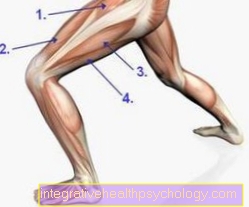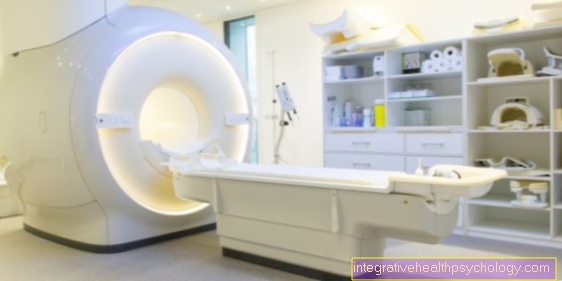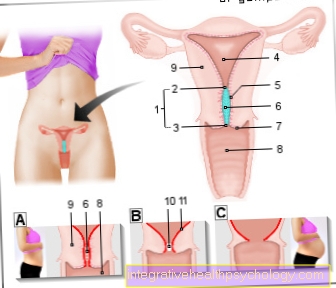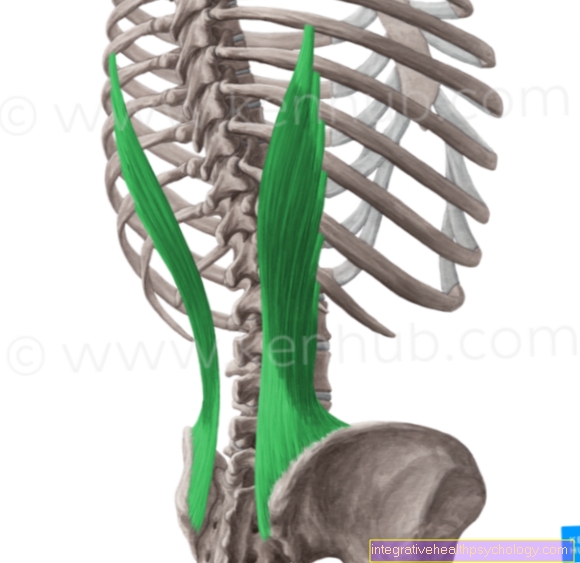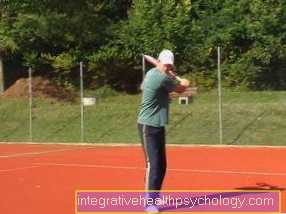Breathing exercises to relax
introduction
Breathing exercises for relaxation are exercises that are intended to put the body and mind in a relaxed position. Without aids, you can do simple breathing exercises at any time and place to collect yourself and relax. Breathing exercises are particularly suitable for this, as breathing influences our body and can thus positively influence and dampen it in stressful situations.
On the other hand, breathing exercises are useful to fix the tense mind on the breathing and to suppress unpleasant thoughts and brooding.
Read more on the topic: Breathing exercises to help you fall asleep

manual
Basically there are a variety of different breathing exercises and it makes sense to try a few different ones to find one that makes you feel best personally and that works most effectively for you individually. Relaxation techniques are not necessarily immediately successful and it takes a little practice to calm the body and mind quickly with simple breathing exercises and bring them back to a comfortable position, especially in a restless and stressful environment, such as at work.
Read more on the topic: Relaxation techniques
It makes perfect sense to practice breathing exercises first at home in a quiet, familiar environment so that you can then use them when you are tense. It can be helpful to imagine the same instructions for the exercises to oneself in order to make it easier for the mind to focus on the exercise in a “mantra-like manner”. Breathing exercises can be combined well with perception exercises such as from the autogenic training can be combined or carried out in isolation.
Read more on the topic: Autogenic training
For example, a breathing exercise for relaxation might look like this.
“I can feel my breath flowing in through the tip of my nose and my chest lifting. If I want, I can feel the movement of my chest and maybe my stomach when I put my hands down. When I exhale through the loosely parted lips, my chest sinks again, the breath flows calmly. I now try to breathe deeper into my stomach with every breath without exerting myself. I breathe deeper and more evenly, my flanks expand with every breath, my abdominal wall gently rises when I breathe in and lowers when I breathe out. I focus on the direction of my breathing for about 6 breaths. Then I breathe normally for a few breaths. Then I breathe in deeply into the flanks again, counting up to 4, taking a relaxed breath after inhaling, and then let the air flow quickly through the opened lips. There may be a slight breathing sound when you exhale. When you exhale, all tension is released. I can also take 2-3 breaths of the second exercise. "
Read more on the topic: Breathing exercises
How do you relax the diaphragm?
Bad posture, stress, and shallow breathing can cause our diaphragms to cramp up and work less well. For physiological (abdominal) breathing, however, it is essential that this important muscle supports inhalation. The diaphragm is also important for the posture of our spine.
In order to loosen our diaphragm and at the same time to make it functionally active, certain breathing exercises are recommended. Exercises in the seat should be discussed here, as these can also be incorporated into everyday office life and support the relaxation of breathing:
From the upright position, with both feet firmly under the knees, the pelvis and back straightened, you reach for the left side of the chair with your right hand and hold on tight. The left hand extends slightly over the head to the right side, the entire left side becomes long and stretches. The breath should now flow into the far left side of the chest. You can feel the side stretch and relax. Breath flows in through the nose and out again through the mouth, breathing is calm and at its own pace. Then do the exercise on the other side. Each side can be practiced for about 1-2 minutes. Before changing sides, it makes sense to take a short break to avoid hyperventilation (tingling in the mouth or fingers - urgently pause the exercise).
Read more on the topic: Diaphragmatic breathing
Breathing exercises for panic attacks
A panic attack is represented by a relatively sudden swelling of intense fear. The fear is relatively undirected, but can often relate to one's own body and is accompanied by physical symptoms such as palpitations, accelerated breathing, cold sweat. In order to suppress the increasing fear, it can be helpful to concentrate on your calmly flowing breath and to force yourself to breathe evenly and deeply through targeted exercises. However, breathing alone may not be enough to regulate panic attacks.
Read more on the topic: Panic attack
Excessive, rapid breaths can lead to hyperventilation, which can be quite threatening for the patient. Here it can help to breathe in a bag for a short period of time to counteract hyperventilation. For patients with frequent panic attacks, it can be useful to practice "emergency breathing exercises" to calm them down. It is useful to consult a doctor or psychologist.
Read more on the topic: Hyperventilation
Duration and frequency of use
Breathing exercises for relaxation can always be done if it feels good. At the beginning it may be useful to learn exercises in a calm environment in order to be able to use them successfully in everyday life. Breathing exercises can provide a little break and relaxation in everyday life within 2-3 minutes, but they can also be used as part of general relaxation exercises. Deeper, stronger breathing should not be done for more than 2-3 minutes to avoid hyperventilation. After a short break in which you can breathe normally, you can start another round of breathing exercises.

